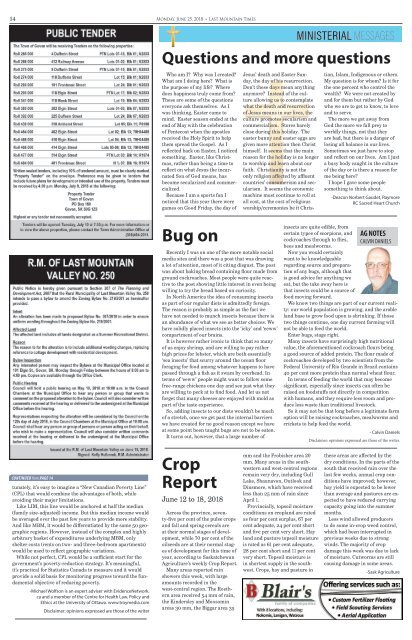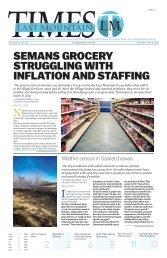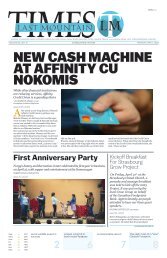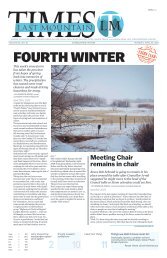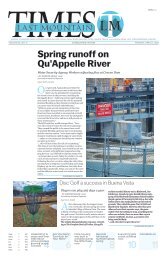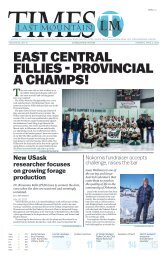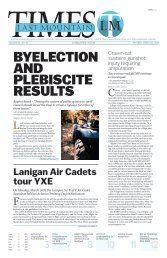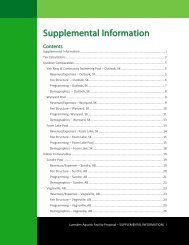LMT_20180625 colour
You also want an ePaper? Increase the reach of your titles
YUMPU automatically turns print PDFs into web optimized ePapers that Google loves.
14 Monday, June 25, 2018 • Last Mountain Times<br />
MINISTERIAL MESSAGES<br />
Questions and more questions<br />
Who am I? Why was I created?<br />
What am I doing here? What is<br />
the purpose of my life? Where<br />
does happiness truly come from?<br />
These are some of the questions<br />
everyone ask themselves. As I<br />
was thinking, Easter came to<br />
mind. Easter season ended at the<br />
end of May with the celebration<br />
of Pentecost when the apostles<br />
received the Holy Spirit to help<br />
them spread the Gospel. As I<br />
reflected back on Easter, I noticed<br />
something. Easter, like Christmas,<br />
rather than being a time to<br />
reflect on what Jesus the incarnated<br />
Son of God means, has<br />
become secularized and commercialized.<br />
Because I am a sports fan I<br />
noticed that this year there were<br />
games on Good Friday, the day of<br />
Jesus’ death and Easter Sunday,<br />
the day of his resurrection.<br />
Don’t these days mean anything<br />
anymore? Instead of the culture<br />
allowing us to contemplate<br />
what the death and resurrection<br />
of Jesus means in our lives, the<br />
culture promotes secularism and<br />
commercialism. Stores barely<br />
close during this holiday. The<br />
easter bunny and easter eggs are<br />
given more attention then Christ<br />
himself. It seems that the main<br />
reason for the holiday is no longer<br />
to worship and learn about our<br />
faith. Christianity is not the<br />
only religion affected by affluent<br />
countries’ consumerism and secularism.<br />
It seems the economic<br />
machine must continue to roll at<br />
all cost, at the cost of religious<br />
worship/ceremonies be it Christian,<br />
Islam, Indigenous or others.<br />
My question is for whom? Is it for<br />
the one percent who control the<br />
wealth? We were not created by<br />
and for them but rather by God<br />
who we are to get to know, to love<br />
and to serve.<br />
The more we get away from<br />
God the more we fall prey to<br />
worldly things, not that they<br />
are bad, but there is a danger of<br />
losing all balance in our lives.<br />
Sometimes we just have to stop<br />
and reflect on our lives. Am I just<br />
a busy body caught in the culture<br />
of the day or is there a reason for<br />
me being here?<br />
I hope I gave some people<br />
something to think about.<br />
-Deacon Norbert Gaudet, Raymore<br />
RC Sacred Heart Church<br />
Bug on<br />
Recently I was on one of the more notable social<br />
media sites and there was a post that was drawing<br />
a lot of attention, most of it citing disgust. The post<br />
was about baking bread containing flour made from<br />
ground cockroaches. Most people were quite reactive<br />
to the post showing little interest in even being<br />
willing to try the bread based on curiosity.<br />
In North America the idea of consuming insects<br />
as part of our regular diets is admittedly foreign.<br />
The reason is probably as simple as the fact we<br />
have not needed to munch insects because there is<br />
an abundance of what we see as better choices. We<br />
have solidly placed insects into the ‘icky’ and ‘eeww’<br />
compartment of our brains.<br />
It is however rather ironic to think that so many<br />
of us enjoy shrimp, and are willing to pay rather<br />
high prices for lobster, which are both essentially<br />
‘sea insects’ that scurry around the ocean floor<br />
foraging for food among whatever happens to have<br />
passed through a fish as it swam by overhead. In<br />
terms of ‘eeww’ people might want to follow some<br />
free-range chickens one day and see just what they<br />
are willing to peck at to find food. And let us not<br />
forget that many cheeses are enjoyed with mold as<br />
part of the taste experience.<br />
So, adding insects to our diets wouldn’t be much<br />
of a stretch, once we get past the internal barriers<br />
we have created for no good reason except we have<br />
at some point been taught bugs are not to be eaten.<br />
It turns out, however, that a large number of<br />
insects are quite edible, from<br />
certain types of scorpions, and<br />
cockroaches through to flies,<br />
bees and mealworms.<br />
Now you would certainly<br />
want to be knowledgeable<br />
regarding source and preparation<br />
of any bugs, although that<br />
is good advice for anything we<br />
eat, but the take away here is<br />
that insects could be a source of<br />
food moving forward.<br />
AG NOTES<br />
CALVIN DANIELS<br />
We know two things are part of our current reality:<br />
our world population is growing, and the arable<br />
land base to grow food upon is shrinking. If those<br />
two things continue, one day current farming will<br />
not be able to feed the world.<br />
Enter bugs, stage right.<br />
Many insects have surprisingly high nutritional<br />
value, the aforementioned cockroach flours being<br />
a good source of added protein. The flour made of<br />
cockroaches developed by two scientists from the<br />
Federal University of Rio Grande in Brazil contains<br />
40 per cent more protein than normal wheat flour.<br />
In terms of feeding the world that may become<br />
significant, especially since insects can often be<br />
raised on foodstuffs not directly in competition<br />
with humans, and they require less room and produce<br />
less waste than traditional livestock.<br />
So it may not be that long before a legitimate farm<br />
option will be raising cockroaches, mealworms and<br />
crickets to help feed the world.<br />
- Calvin Daniels<br />
Disclaimer: opinions expressed are those of the writer.<br />
CONTINUED from PAGE 14<br />
tunately, it’s easy to imagine a “New Canadian Poverty Line”<br />
(CPL) that would combine the advantages of both, while<br />
avoiding their major limitations.<br />
Like LIM, this line would be anchored at half the median<br />
(family size-adjusted) income. But this median income would<br />
be averaged over the past few years to provide more stability.<br />
And like MBM, it would be differentiated by the same 50 geographic<br />
regions. However, instead of the complex and highly<br />
arbitrary basket of expenditures underlying MBM, only<br />
shelter costs (rents on two- and three-bedroom apartments)<br />
would be used to reflect geographic variations.<br />
While not perfect, CPL would be a sufficient start for the<br />
government’s poverty-reduction strategy. It’s meaningful,<br />
it’s practical for Statistics Canada to measure and it would<br />
provide a solid basis for monitoring progress toward the fundamental<br />
objective of reducing poverty.<br />
-Michael Wolfson is an expert adviser with EvidenceNetwork.<br />
ca and a member of the Centre for Health Law, Policy and<br />
Ethics at the University of Ottawa. www.troymedia.com<br />
Disclaimer: opinions expressed are those of the writer<br />
Crop<br />
Report<br />
June 12 to 18, 2018<br />
Across the province, seventy-five<br />
per cent of the pulse crops<br />
and fall and spring cereals are<br />
at their normal stages of development,<br />
while 70 per cent of the<br />
oilseeds are at their normal stages<br />
of development for this time of<br />
year, according to Saskatchewan<br />
Agriculture’s weekly Crop Report.<br />
Many areas reported rain<br />
showers this week, with large<br />
amounts recorded in the<br />
west-central region. The Rosthern<br />
area received 54 mm of rain,<br />
the Kindersley and Moosomin<br />
areas 30 mm, the Biggar area 35<br />
mm and the Frobisher area 20<br />
mm. Many areas in the southwestern<br />
and west-central regions<br />
remain very dry, including Gull<br />
Lake, Shaunavon, Outlook and<br />
Dinsmore, which have received<br />
less than 25 mm of rain since<br />
April 1.<br />
Provincially, topsoil moisture<br />
conditions on cropland are rated<br />
as four per cent surplus, 67 per<br />
cent adequate, 24 per cent short<br />
and five per cent very short. Hay<br />
land and pasture topsoil moisture<br />
is rated as 61 per cent adequate,<br />
28 per cent short and 11 per cent<br />
very short. Topsoil moisture is<br />
in shortest supply in the southwest.<br />
Crops, hay and pasture in<br />
these areas are affected by the<br />
dry conditions. In the parts of the<br />
south that received rain over the<br />
last few weeks, annual crop conditions<br />
have improved; however,<br />
hay yield is expected to be lower<br />
than average and pastures are expected<br />
to have reduced carrying<br />
capacity going into the summer<br />
months.<br />
Less wind allowed producers<br />
to do some in-crop weed control,<br />
which had been interrupted in<br />
previous weeks due to strong<br />
winds. The majority of crop<br />
damage this week was due to lack<br />
of moisture. Cutworms are still<br />
causing damage in some areas.<br />
-Sask Agriculture


